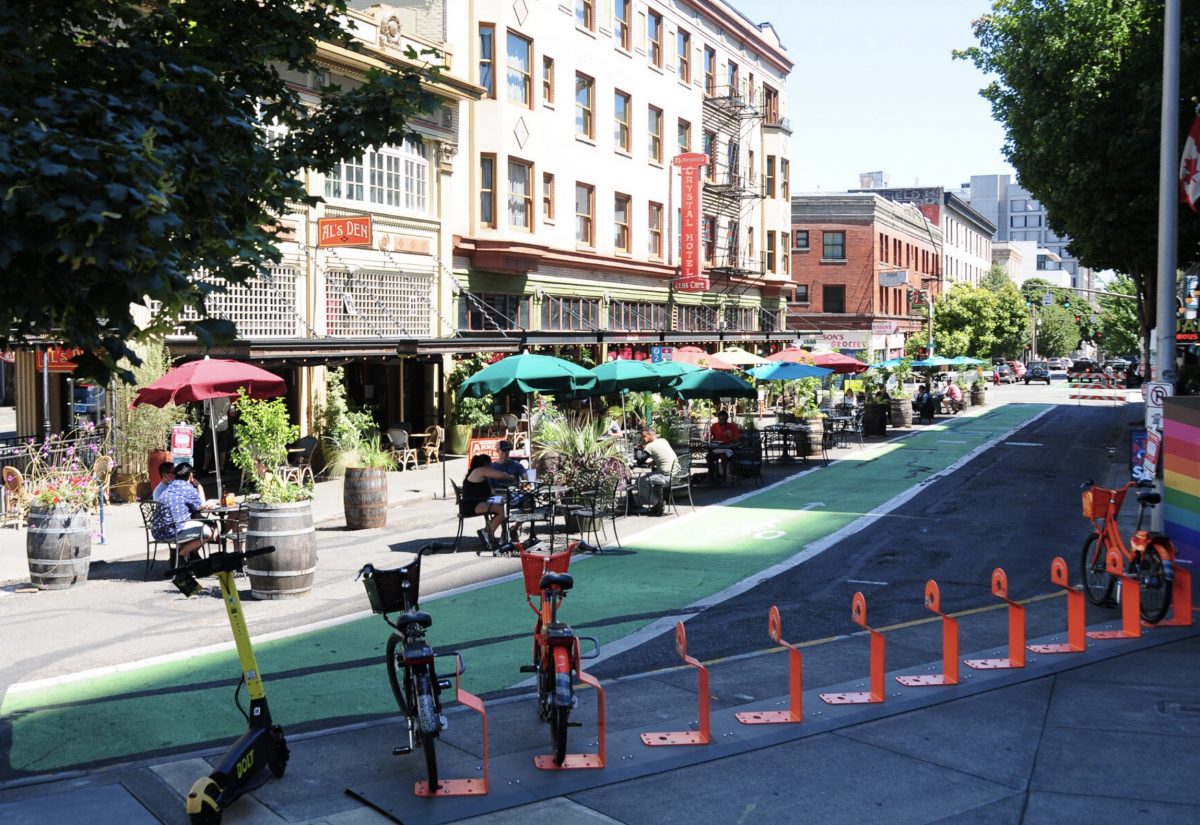
(Photos: J. Maus/BikePortland)

(Photo: City of Portland)
City Commissioner Jo Ann Hardesty has been in charge of the Portland Bureau of Transportation for only about a week but she’s already got the ball rolling on a few priorities. Hardesty’s Policy Director Derek Bradley popped into the monthly meeting of the city’s Bicycle Advisory Committee Tuesday to share some of her “first blush thoughts” on goals for the bureau.
The first priority Bradley shared (much to the surprise of BAC members, who weren’t warned beforehand about the remarks) is that Commissioner Hardesty is interested in creating carfree streets downtown. To be precise, “Exploring, identifying and executing on closing some roadways permanently to car traffic,” is how Bradley put it.
Advertisement
Bradley said carfree streets are one of Hardesty’s top priorities and added that their office has already reached out to PBOT to research the issue and develop materials to help seed the conversations to come. Specifically, they’ve asked PBOT staff to determine which locations would be most viable to prohibit driving. It’s the first step to what will be a future outreach process that will gauge the feedback and interest of Portland business leaders, community groups, and other advisory councils.
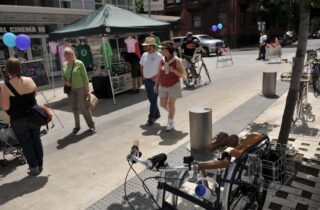
We’ve been pushing for more humane, safe, quiet and healthy spaces downtown for many years — ever since Portland hosted the Towards Carfree Cities Conference in 2008. In August 2019, amid a spate of traffic fatalities, I published an opinion piece right here on the front page calling for our leaders to unlock Portland’s potential by reducing the amount of cars downtown. Here’s an excerpt:
While those who work at PBOT and City Hall struggle to make progress on Vision Zero goals, they might want to take a look out their office windows. There are simply too many cars and too many people who use them irresponsibly. Want fewer people to die? Want to unlock the vast potential of our streets? Want people to be healthier, wealthier and happier? If so, we must have a laser focus on reducing the amount of cars on the road. It’s not enough to make incremental progress for bicycling, walking, and transit. As long as driving is perceived as being cheaper, easier, and safer, too many people will choose to do it too often.
In 2019 San Francisco banned driving on a 2.2-mile stretch of a major downtown thoroughfare, yet despite Portland’s progressive transportation reputation, we have a precious little amount of carfree space. A one-block stretch of SW Montgomery on the Portland State University campus most recently became carfree. There’s also the one-block stretch of SW Ankeny.
Advertisement
We don’t know exactly why this is such a big priority for Commissioner Hardesty (yet), but it should come as no surprise. In 2018 we shared how her campaign website included a page on “Climate Justice” that stated, “I believe in a Portland where you can get where you need to go without using a car.” Hardesty is also a huge supporter of free and reliable transit service. Downtown is very well-served by transit, which makes not using a car much more feasible. In 2009, Portland Planning Commissioner and Metro council candidate Chris Smith shared his belief that the presence of buses, MAX light rail lines, streetcars, bike share and electric scooters all work together to create a, “Useful framework to look at supporting a dramatic reduction in auto reliance in the Central City.”
This is an auspicious moment to have this conversation, given how the demand on public space is at an all-time high due to social distancing requirements brought on by the Covid-19 crisis. Many downtown Portland streets that are good candidates for going carfree are already half-way there thanks to PBOT’s Healthy Business permit program which has allowed dining plazas in the right-of-way.
There are several low-hanging fruit locations that have been discussed in the past: NW 13th (north of Burnside), the transit mall on 5th and 6th, SW Harvey Milk (between 10th and 13th), the Park Blocks, and Director Park.
Hardesty, 61, counts herself among the many Portlanders who are too afraid of cars to ride on our streets. Remove cars and she’d be more likely to give it a try. In a 2019 interview she told me she was contemplating buying a new bike. “I think I’ll practice in my apartment complex first before I feel brave enough to take it onto the street,” she said.
— Jonathan Maus: (503) 706-8804, @jonathan_maus on Twitter and jonathan@bikeportland.org
— Get our headlines delivered to your inbox.
— Support this independent community media outlet with a one-time contribution or monthly subscription.


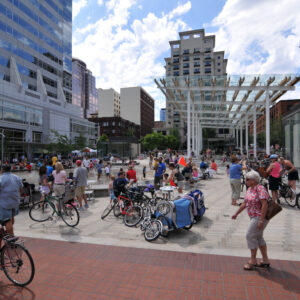
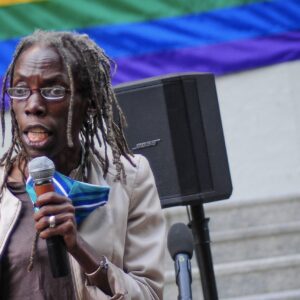
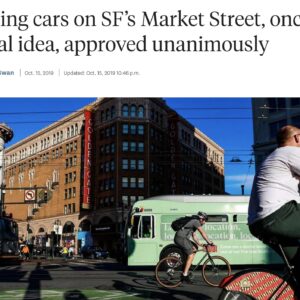
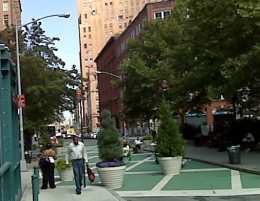
Thanks for reading.
BikePortland has served this community with independent community journalism since 2005. We rely on subscriptions from readers like you to survive. Your financial support is vital in keeping this valuable resource alive and well.
Please subscribe today to strengthen and expand our work.
Let’s not forget the option of simply reducing the amount of street width dedicated to cars that are either being driven or parked. Eliminating cars often has related vehicular access (and political) issues for residents and businesses. Your photo of Stark/Harvey Milk reminds me of how the closing of one block of Stark may be more symbolic than actually making a real difference. Limiting and not eliminating vehicle dominance on selected streets may often be a more practical option. Going back to Stark (and Oak), I think of how helpful it was to remove 1 of 2 travel lanes for cars on Stark and Oak between 12th and Naito. When the choice is a block or two car free or many blocks with a protected bike lane, I’ll go for the latter every time.
I’m sure many motorists thought at the time the world would end when the Stark/Oak car lanes went away, but here we are years later, and no problem. Driving is a reality, and I think an emphasis on sharing and coexisting will take us further than ped/bike v. car fights. We generally have enough of us v. them mentality going on already.
In addition, we should be looking for the next “Better Naito” projects where we apply temporary measures, see how they work, fine-tune, and ultimately implement as permanent solutions. With the lower Covid-related traffic volumes probably remaining for much of this year, it’s a perfect opportunity to try the next generation of Better Naito projects across the city.
“When the choice is a block or two car free or many blocks with a protected bike lane, I’ll go for the latter every time.”
IS that the choice? How about eliminating cars (with the exception of deliveries) on the Park couplet? A network of protected bike lanes should be PBoT’s priority, but a network of carfree streets, even better.
Park Ave should have one side be a dedicated greenway with permanent outdoor seating and food cart pods, all the way from PSU to the USPS site and then the other half can be two way traffic with no parking.
It would connect O’Bryant, North Park Blocks, South Park Blocks, PSU and all the new developments in the Pearl.
When I typically think of a shared street with cars and pedestrians, I think of various European inner cores, but the reality is that we Americans already have numerous successful examples in all of our cities, major and minor, in front of every supermarket, Walmart, and Target store.
That’s a good observation. I’ve pointed it out to people often, for instance when PBOT or “pedestrian advocates” push for building sidewalks on streets with little vehicle traffic that would function much better as shared-use (“woonerf”) spaces. Millions of people walk in parking lots amongst moving cars everyday, without getting hit. Drivers are aware of the people walking, and don’t question their right to be walking there, so drive cautiously, and it all works.
I agree! Buildings, shops, and restaurant owners are almost always going to want car access to their entrances. And there is evidence that having high-turn-over customer parking directly in front of their shops does bring in non-negligible revenue for their businesses. For that reason, pedestrian only streets on the vast majority of city streets is likely to harm the businesses on those blocks which will lead to backlash against PBOT, harming the progress that we are trying to make on moving away from car dependence.
I think it would be better for us to spend the political energy and PBOT money limiting the number of travel lanes, changing the timing of lights, reducing the travel lane widths, installing automatic speeding cameras, etc. to reduce the speeds of cars and make room for other road users. Seems to me that it is better to make these changes on as many streets as we can versus expending all our political will on a few blocks of pedestrian only areas.
If you’re trying to go beyond that space, sure okay. But what if you’re already in the area and only need to travel a block? Or more to the point: what if you’re a pedestrian?
“we should be looking for the next “Better Naito” projects”
A project that created an absurdly expensive bike lane a mere 50 yards from a safe separated multi-use path.
Meanwhile dozens of people die each year in outer areas of Portland that lack sidewalks, sufficient signaled crosswalks, safe routes to schools, and minimal levels of bike infrastructure.
(The seasonal bottlenecks were not a result of the MUP but rather a result of parks allowing private orgs to host parties on public park space.)
Could be cool. But have to comment on one intriguing statement in the article:
“Hardesty, 61, counts herself among the many Portlanders who are too afraid of cars to ride on our streets.” I agree there are lots of people in this camp.
I don’t see how making a few blocks here and there car free is going to make one feel safer to ride bikes around town. Protected or even semi-protected bike lanes yes, car free plazas not so much.
Flipping the hierarchy so ped/bike/local biz gets top priority and “cars are guests” on slow streets (<20mph) could allow for more extensive rollout;
Implementing Madrid-style superblocks could make it so the streets are, for all intents and purposes, car-free.
That leaves 100% car-free streets to the specific points where they would have the greatest impact (schools, parks, entertainment districts).
For anyone unfamiliar with “superblocks“, they are essentially a means to divert through traffic around neighborhoods and not through. Reducing cut through car access to neighborhoods has been one of the key means to transform neighborhoods into safe, quiet, prosperous, walking areas in Madrid and other cities.
In Portland, especially downtown, around one neighborhood often means through another.
I see your point, but typically these superblocks come with PBLs on the main streets and either pedestrianized, or severely limited access for cars on the local access streets.
perhaps instead of building bougie streetscapes designed to boost the real-estate/consumption economy we could rapidly build out active-transportation *priority* routes in areas where people are unnecessarily dying on our streets (e.g. not the central city).
we could even call these things…drumroll…greenways.
note: greenways are a cheap kludge. imo, what we really need is more dedicated infra but in this bougie city i don’t expect this kind of political will to develop any time soon.
How about taking a regular through arterial like Burnside or Division and making it car-free for its entire 7-10 mile length for certain hours during the day, say 10 am to 3 pm, then a 15mph shared street from 3 pm to midnight, and unrestricted to cars at 25mph from midnight until 10 am? To regulate traffic and keep in check the faster SUVs and 85th percentile and drunk drivers, you could employ periodic movable bollards every few blocks like I saw in Maastricht: https://www.google.com/maps/@50.848734,5.689058,3a,75y,180h,90t/data=!3m6!1e1!3m4!1siH4gPPV6-QwbWkFJcGS8KQ!2e0!7i13312!8i6656 or the gates on SW Salmon at Broadway: https://www.google.com/maps/@45.5166841,-122.6810702,3a,75y,286.12h,90t/data=!3m7!1e1!3m5!1sF6cD4mL4VwCnc0UuCoFpSA!2e0!6s%2F%2Fgeo1.ggpht.com%2Fcbk%3Fpanoid%3DF6cD4mL4VwCnc0UuCoFpSA%26output%3Dthumbnail%26cb_client%3Dmaps_sv.tactile.gps%26thumb%3D2%26w%3D203%26h%3D100%26yaw%3D292.41855%26pitch%3D0%26thumbfov%3D100!7i16384!8i8192
“Portlanders have been ClAmORiNG for”… Goes on to quote themselves lmao.
Yeah that was pretty bad. I edited the piece to say BikePortland has been pushing for carfree streets. Thanks.
The problem I have with car-free streets is that every car-free street immediately becomes a pedestrian-priority street. Try riding your bike quickly in any car-free setting – think of the car-free streets on the PSU campus – and immediately you will come into conflict with pedestrians, who give you the stink-eye and even yell at you. And you as a cyclist have to dodge the peds. Parents with small children see these car-free streets as great places to let the kiddies roam, so we cyclists are then playing Pac-Man, having to avoid little kids randomly pinging in our direction. In fact, on the PSU campus there are now many car-free streets designated as “pedestrian only” and you’re supposed to dismount your bike and walk.
I much prefer a bike lane on a regularly trafficked street for moving on a bike quickly and efficiently. Car-free streets are really not safe for cyclists b/c the cyclists are not safe from the pedestrians.
I hear you Fred but did you ever stop to think that maybe being able to quickly bike through a space isn’t the top priority in every policy and project? I personally don’t expect carfree spaces to be on major bikeway routes… and if they are I would expect that the bikeway movements would be sufficiently preserved.
I’d also encourage everyone to be very open-minded at this point! Let’s acknowledge that this is an exciting potential initiative and let’s put our collective energy toward supporting it instead of nitpicking at this stage. Thanks.
Thank you, Jonathan. We’re all pedestrians more often than we are cyclists or drivers.
Not me, raktajino – I’m a cyclist *way* more often than I’m a pedestrian or driver. Plus I thought this is BIKE-Portland, not PED-Portland.
Just because you manufacture hammers doesn’t mean that you believe that hammers are a good tool for every situation, or that the use of other tools is detrimental to hammers.
It’s when the screwdrivers start blocking hammers from public space that we have a problem.
It’s one thing if bikes are displaced in favor of cars, but if a public space is created where people, as pedestrians, can just hang out, I really don’t see the problem. I agree that there are inadequate facilities for bikes, but I just don’t think the solution is to have fewer pedestrianized spaces.
If someone plunks down a pedestrian plaza in the middle of a bike corridor, I think it would be a problem. The details matter, of course.
This is not an argument against pedestrian spaces, just for not putting them places that interfere with bike travel.
*where mostly well-off white people can hang out
Soren: Do you think it’s possible to create pedestrianized spaces in a manner that caters to people of all backgrounds (racial, economic, geographical location, etc.) in an equitable manner? Or do you believe that such spaces will necessarily only be enjoyed by well-off white people, no matter how they are implemented? To make myself clear, I don’t think that creating carfree spaces in downtown alone is the solution. I don’t think they should only be created in the central city, and I don’t think they are the only things that should be created. Like I said, hammers are not the only tool. That applies to pedestrianized spaces as well as well as cycling or public transit infrastructure (not to mention sidewalks, signalized crossing, etc.).
I believe Portland’s economy is a mostly a zero-sum game and that this kind of well-intentioned “reform” often increases inequality by reducing funds available for reform outside of the urban center.
It is also my observation that these kinds of amenities are exclusionary to people who live in low income housing in central PDX or who live outside. Twee economic redevelopment of urban centers has a long history of soul crushing displacement of very low-income housing to the more “affordable” periphery.
From a position of compromise, I could support this kind of benefit for mostly well-off people if it were specifically linked to larger investments in less well-off areas. Unfortunately, this kind of compromise seems, to me, to be outside of Portland’s Overton window.
In other words, doing anything that improves the city is inequitable.
Is there no absurd outcome that “equity” cannot be used to justify?
Improvements for H, K while poor people curl up and die on our streets.
Any screwdriver that does that is a tool.
Ride your bike down the aisles of a grocery store, do you? Up and down the stairs of your apartment?
Bikeportland talks a LOT about Vision Zero and walkability of streets. It’s not off-topic to recognize the needs of pedestrians in a real no-car-deaths and everyone-doesn’t-need-cars future.
Truth
Downtown sure, but hit me up with some eastside carfree streets!
I think a simple model to follow would be SE 26th and Clinton. For those that haven’t been by, basically one block between 25th and 26th no longer lets cars through. Instead, there is double-ish wide bike lane running between extended seating/pedestrian/bike parking areas.
This seems win win win to me. It is already a greenway street with diverters, so this is just a slightly more dramatic one. Obviously it helps limits car traffic up and down Clinton a bit. Makes that even more of a destination block to gather (let’s just pretend covid is going away, so I can make it through the day…). A very approachable bike destination for the non-fearless crowd.
Yeah, Ankeny at 28th is similar. People on bikes slow down for a block and get way more in return. That’s how every 5 blocks on a greenway should look.
This is fantastic news, and I look forward to Commissioner Hardesty’s leadership on this!
This is great news! And the time is right as many retailers, bars and restaurants owners have turned a 180 on what is more valuable to their success: on street vehicle storage or vitality (humans eating & shopping and physically moving in the street).
There are great many long established models for commercial streets* with lite / limited (balanced) motor vehicle access for deliveries etc. *’Winkelerven” concept for living shopping streets like Woonerven but for commercial zones.
I hope they plan then to lisence and tax bike riders as they do cars and people. Bikes should be lisenced as a car is and be able to contribute to the up keep of roads and by ways and also be held accountable for not following the rules of the road.
My 5 year-old has 2 bikes. Are you saying that she needs to pay $120 per year to ride bikes around our neighborhood?
Ah awesome … mature response. No if you are riding on city streets like cars it is your responsibility as a rider to follow certain rules. If a bike is going to take away my driving ability in the core of the city then I believe those riders should accept the burden of the fees put on cars ie licensing , insurance etc. I mean shouldn’t we all be equal ??
Bicycles and motor vehicles are not equal: in the law, in physics, in damage to the roads, and in likelihood to maim or kill. Your position is silly.
But aren’t both designed (currently) to move people? And aren’t they operated by humans? We need to raise revenue, so why not a basic user fee, then added fees for engines, vehicle weights, heights of bumpers, Rapha stickers, etc?
I’d be okay with a registration fee that scales with curb weight. Maybe $0.25 per pound?
Licensing 4 year-olds might be a bigger issue, though.
Even rich 4-year-olds pay taxes, and poor and middle-class ones provide tax deductions and extra exemptions, plus I’ve met many who are far more predictable riders than their (oft distracted) parents. For equity purposes, I’d base the rate on MSRP rather than weight. In many poorer communities that lack bike shops such as in EP, the only new bikes for sale are Next and Magna.
Who’s ridden carfree Tabor lately? Tried to do a few laps this morning. Wall-to-wall peds, strollers and dogs, 4, 5, wide, some dogs leashed, some aren’t, and very little in the way of self-awareness. Between covid and the massive onslaught of the newly arrived, cycling in and around this town is getting harder and harder to do.
As to Commissioner Hardesty’s suggestion to create more carfree plazas, picture the Saturday market at PSU. There’s no reason to think carfree plazas downtown are going to be any different, as in no place for a bicycle.
I agree with the posters recommending the removal of parked cars on busy streets or on greenways.
I’m way comfortable riding with cars.
I’m way not comfortable riding in the door zone.
It’s no wonder gravel riding is so popular.
I would encourage people who agree with Hotrodder to consider the difference between the traditional vehicular cycling ideology as espoused here, and the idea that people are essentially bags of meat slung on a couple of metal tubes. Feeling comfortable does not indicate safety, nor does it further the goals of making streets safe for children and old people, who are disproportionally killed by cars. “Wall-to-wall peds” is a persistent complaint by cyclists in NY who see PBLs swarmed by pedestrians. The problem is not that we should not make more space for pedestrians at the expense of people on bikes, it’s that we maintain the vast majority of space for cars.
I interpret Hotrodder as supporting the sharing of space between different modes, rather than giving it over to one or the other. There are many contexts where I agree with this (and plenty where I don’t), but maybe the key question is not how much space we maintain for cars, but how to establish norms of behavior that make sharing that space safer and more feasible for everyone.
Bikes and cars can co-exist safely, but neither mixes well with pedestrians.
More room for tents too.
Win win.
While we remain in this antiquated system of commissioner-in-charge form of government, this is great news. Downtown has WAY too much space dedicated for cars -both parking and movement. If the work-from-home situation continues in any substantial form, this could be an easier pill to swallow for the PBA who are even more antiquated than the commissioner form of government we’re living with. Downtown would be an amazing place with truly pedestrianized streets like our European counterparts.
Unbelievable! Clean up the mess you guys created, you know all the crime. Really a car was just stopped at the light, and got shot?. This is everyday! Enough some one do their job!!!!
The two photos in the article both seem like great locations for eliminating vehicles. The top one on Harvey Milk would make a great plaza given its location and restaurant uses on both sides. The Director Park one would allow direct access to the park/plaza from the adjacent building without crossing a street, which is a real flaw with Pioneer Square, Keller Fountain, and the Park Blocks.
I see the value in closing streets primarily being creation of plazas that people come to to be in an “outdoor room” vs. being a linear route used for walking or biking transportation. Others’ ideas of reducing vehicle lanes (but not eliminating all of them) to create more room for walking and biking seem better for that. It’s not one vs. the other. They serve different purposes (place vs. route) and both are needed.
Maybe if bikes had to be registered and licensed to pay the expense of line delineation and upkeep. Automobiles pay gasoline tax to finance the upkeep of the roads being used, Cyclists need to pay their fair share.
I have yet to see any analysis that people who ride bikes somehow underpay for road upkeep. Because a bike does essentially zero damage to roads, one could argue that by riding instead of driving, cyclists save the city more money than would be generated by the gas tax revenue they would pay in their cars.
Of course a real analysis would be far more complex, but it’s not at all clear that bike riders pay too little (just as it is unsubstantiated that car drivers are subsidized). Either might be true, but without evidence, it’s just religion.
Automobiles pay gas taxes? How does a car pay a tax?
We all pay gas taxes, including people like myself who don’t drive. We pay for it indirectly through our shipping fees with USPS, UPS, FedEx, and Amazon, as well as the retail prices we pay for goods in stores, and through bus, taxi, and uber fares. We also pay for roads with our federal income taxes, as the gas fund effectively went bankrupt way back in 1993.
Like the pedestrian block of Ankeny, it still feels weird to me to have the sidewalk in between the tables and the cafes…servers crossing paths with pedestrians. I’ve been on many streets and plazas with sidewalk cafes but Portland is the only place I’ve seen it this way.
I agree that’s weird. I’ve seen older photos of Ankeny where that’s true, but I’ve been there several times over the last couple years (not in a few months though) where the tables are to the side and you walk down the middle, like this in 2019: https://www.google.com/maps/@45.5225218,-122.67224,3a,60y,270h,90t/data=!3m6!1e1!3m4!1sGOWtFaOohjqhE3f37j-7Ag!2e0!7i16384!8i8192
By chance, this view from a few feet away hasn’t been updated since 2007–nowhere I’d go out of my way to experience for sure: https://www.google.com/maps/@45.5225244,-122.6723421,3a,75y,270h,90t/data=!3m6!1e1!3m4!1sTBpdjBOLhRFBkzWZ4koLng!2e0!7i3328!8i1664
Thanks. I wasn’t sure Ankeny had been fixed; maybe heard it had. I wonder why that improvement didn’t inform the Harvey Milk block’s design?
Thanks for this reporting, Jonathan.
Here’s a fairly good study on success & failure of carfree commercial streets. Seems like they multiply existing foot traffic, but can’t lure foot traffic from scratch.
https://s3.amazonaws.com/sitesusa/wp-content/uploads/sites/1061/2016/06/Fresno-attachment-3-americanpedmallexperiment-003.pdf
Helpful:
major tourist destination like Vegas or New Orleans
beach
university
short blocks
urban area under 100k population
Of those, our downtown is 1/5, or 2/5 if you include the PSU area.
Based on this, I’m dubious of the idea that this is a good response in the short term to the near-evacuation of downtown by office employers. This seems like a good thing to try once the buildings fill up again … but first, they need to. Until that happens, we might be setting this great idea up for failure and the discrediting of similar projects in the future.
I am really depressed about the future of downtown for the first several years post-COVID. The teleworking boom is good in lots of ways, but it’s going to devastate downtown retail until a bunch of those empty offices can be converted to residences or something. I was recently speaking to one of the city’s top planners; he said he thinks it’ll be about 10 years until the central city returns to anything like its pre-pandemic level of activity. I think that might be optimistic. We should probably all be adjusting to this situation.
I wonder though if this might be more likely to succeed *outside* downtown, in a neighborhood – say NW 21st/23rd? – that has lots of existing homes full of telecommuters who’ll soon be very eager to go out to lunch.
I could also imagine something near PSU once students are back. Or maybe we’re just talking about one of the little spots like SW Ankeny & Broadway that should have never been open to cars at all.
“The ones that work are the exception, not the rule, and they require some particular characteristics to flourish: high levels of tourist traffic occurring for reasons other than the mall is one; large populations of pedestrians (such as universities or dense downtown housing) in close, walkable proximity is another.” Dave Feehan of the International Downtown Association continues this point by stating, “Most have failed and been removed. Reasons include lack of maintenance, management, and marketing; fear of crime; the movement of retail to the suburbs; poor design; and Americans’ desire to “park in front of the store.” However, some well managed and well maintained examples continue to survive and in some cases thrive…. One factor seems to help significantly: the presence of a major university in close proximity.”
The idea that people will go to a street simply because there are no cars is an idea destined to failure. The research by Fresno Future above is a glimpse into that past world.
In a response to Bloomberg’s opening up on Times Sq in ’09 (still successful) the Grey Lady wrote, “The pedestrian mall, the urban planner’s failed attempt to revitalize Main Streets during the 1960s and 70s, is back!”
In the 50s/60s Moses, Gruen, Louis Kahn and most other planners dreamed of improving life through designing around the car. Luring white suburbanites to giant parking garages was considered the sole means of generating business wealth. Downtown residents (people of color), children and actual workers were not really considered.
Anyone who’s been to Fulton Street in BK, knows how successful it has been for decades. It was redesigned to appeal to white people (drivers from the suburbs) because the city did not consider a primarily black pedestrian street a success.
While the research above is important for understanding this idea, it fails to examine the actual problem. Pedestrians streets are successful not because they lure tourists or whites, they’re successful when they become a place for residents who live there. That is why so many pedestrians streets (eg 34th st Queens) in NY are successful. People in those neighborhoods have a safer and better place and see it as “theirs”.
I think creating a sense of ownership is really important for any sort of community building, and is one reason I support locals having a louder voice in planning for their area (often countered by “the streets belong to everyone”). Local buy-in and support is far more important than that of distant residents.
One problem we have now is that many people fear that making a car-free area will result in it either becoming a “dead zone” or being taken over by campers and other uses that make it a liability. One solution that I philosophically dislike is to let local businesses “privatize” the public realm, and use it for restaurant seating and the like, letting them regulate use of the space (roping it off, for example, or building structures).
Lack of confidence in the city’s willingness and/or ability to enforce any rules suggests new initiatives that depend on people behaving well are likely to fail.
Two great points HK. 1) Traditionally indoor malls were looked at in a similar light as outdoor malls (in the US). If we privatize the police force it will keep the “rabble” out. 2) As for local buy-in, most people in NY were clearly not supportive of open streets during their initiation. De Blasio even removed a few (out of dozens). Hardesty will likely have immense criticism, some genuine and substantive, others just the typical “change is scary” folk, and lots of people who don’t like her skin color. The point is: she will have to be a leader and take the flak in order for neighborhoods to advocate. Once people see how open streets work, and how their children, businesses, and safety benefit, it becomes widely accepted.
On the other hand, if it fails in one major location, they’ll be very afraid to do it anywhere else in the city no matter how conducive the conditions are.
David that is my greatest worry (my second greatest is that these will only happen in rich neighborhoods). When the DOT advocates for opening a number of small streets for trial basis, and continue with neighborhood support, as is what happened in NY, it is 1) more effective politically and 2) more helpful to the general populous. If Hardesty chooses to open a single high profile street it can be looked at as a case study and not an enduring movement. That is why IMO the easiest and safest first step might be to augment existing neighborhood boulevards by turning Eudaly signs into physical divertors.
What if pedestrianized plazas only have sufficient support in wealthier neighborhoods? This seems quite plausible given the confluence between higher incomes, appropriate project locations, and likely supportive “urbanist” populations. Not many of these are going to be built in E Portland.
Would that be a reason to not fully support the proposal?
I say this as a former (and somewhat perpetual) resident of E Portland, who laments the suburban-style infrastructure and history of lack of investment. The most salient difference for our means here between poor neighborhoods (eg Brownsville) in NY and East Portland is density. Unfortunately, East Portland in general does not have the density required for car free streets. That does not mean PBLs on thoroughfares and divertors on bike boulevards cannot be transformational.
Another factor to consider is that areas with the commercial density to support a pedestrianization project (on the eastside, at least) will likely face opposition from PBOT given their concern for motorized commute times from areas further out.
I predict that if this proposal goes anywhere, it will primarily be limited to inconsequential streets in and adjacent to downtown and a few quirky places where commercial districts don’t fall on commute routes (NE 28th, 26th & Clinton, etc. — which tend to occur in wealthier neighborhoods).
IMO, I’d say Ankeny from 12th to 28th is the most likely candidate for a pedestrianized Oxford Street, followed by Harvey Milk, then Belmont from 30th to 39th. NW 23rd will get vetoed by that business association and Mississippi is an emergency route (if rather a minor one). Burnside and Division are good streets for it but too innovative for conservative Portland; maybe in round 4. As for EP, I could easily see the 4M as a series of dead-ends, diverters, and shared streets – not closed off to cars per se, but very difficult to move through and impossible to move fast, maybe extended to Lincoln/Harrison. Same with Capitol in SW.
Why would you pedestrianize a residential street like Ankeny? The benefits come from streets with supporting commercial activity, such as restaurants, bars, and cafes.
Because that section of Ankeny has restaurants, bars, and cafes.
Not really. There’s Crema at 28th, and maybe one or two other spots, but that corridor is overwhelmingly residential. Plus it’s a major bicycle artery.
HK, let me be clear. I’m not advocating for Ankeny or any of the other locations to be pedestrianized. What I am saying is that given local Portland politics, I’d say these are the most likely to be first on Hardesty’s and PBOT’s hypothetical list.
“The idea that people will go to a street simply because there are no cars is an idea destined to failure.”
I agree. One main type of place street closings here (and it could be closings only during certain times, vs. 24/7) are Portltand’s many small streets that separate parks from the buildings around them (Park Blocks, Director Park, etc.). There’s no pressure on those street closures to draw people, since the draw is the park that’s already there. The purpose of the street closures would be to enhance the park.
The other type of place I see them working is on very short streets (Portland has lots created by diagonal streets like Burnside and Sandy crossing the grid) where they don’t need to attract lots of people to be successful. They just provide some respite for pedestrians, and the vehicle ban doesn’t cause much disruption to businesses, since they have frontage on adjacent streets.
Let me b polite. Recall Hardesty for the good of the city please recall Hardesty thank you
Isn’t this the same ***deleted by moderator*** who just recently made news when her rideshare driver wouldn’t tolerate her horrible garbage attitude and entitlement? Why do you people keep voting in walking dumpster fires?
Ummmm I guess to drive projects like this that are good ideas?
I wish Portland luck in doing this. In under a year, I retire, and we’re moving to Europe where car-free living is so much easier, and where we don’t need to deal with stubborness and misinformation on this topic. No sense in trying to explain it anymore to U.S. Americans who wouldn’t understand no matter how clear you tried to make it.
Has there been any update on this?? What about NE Alberta??